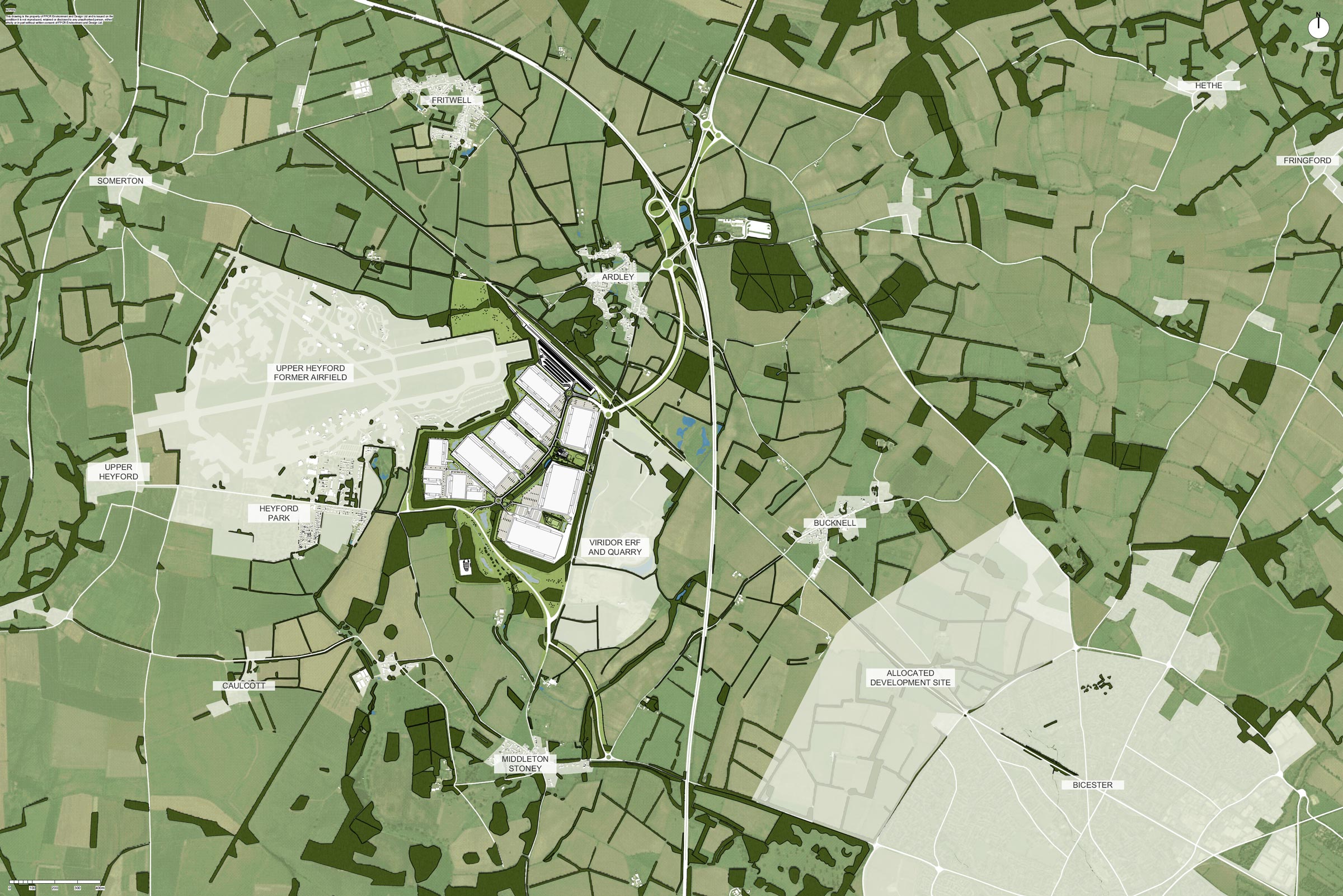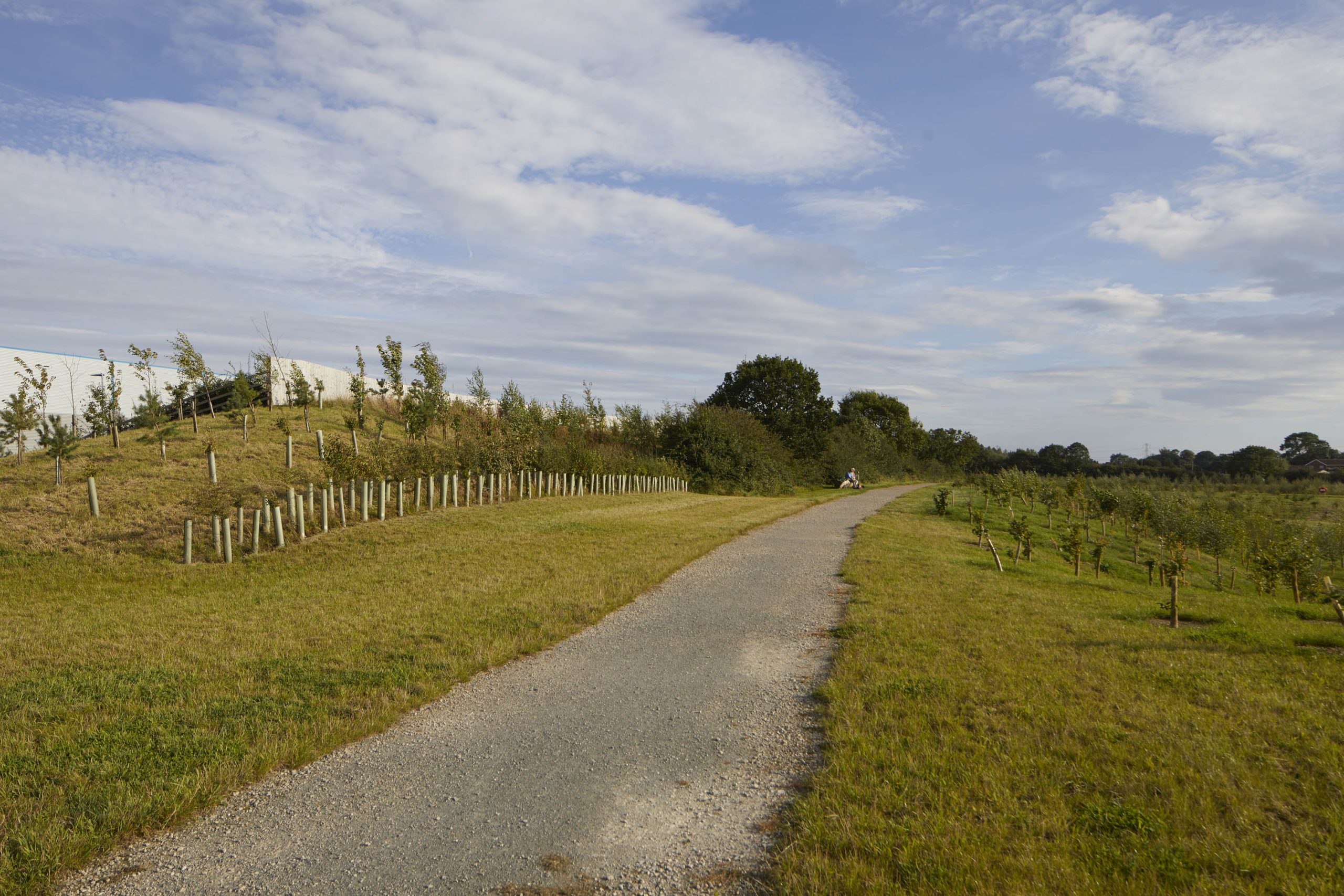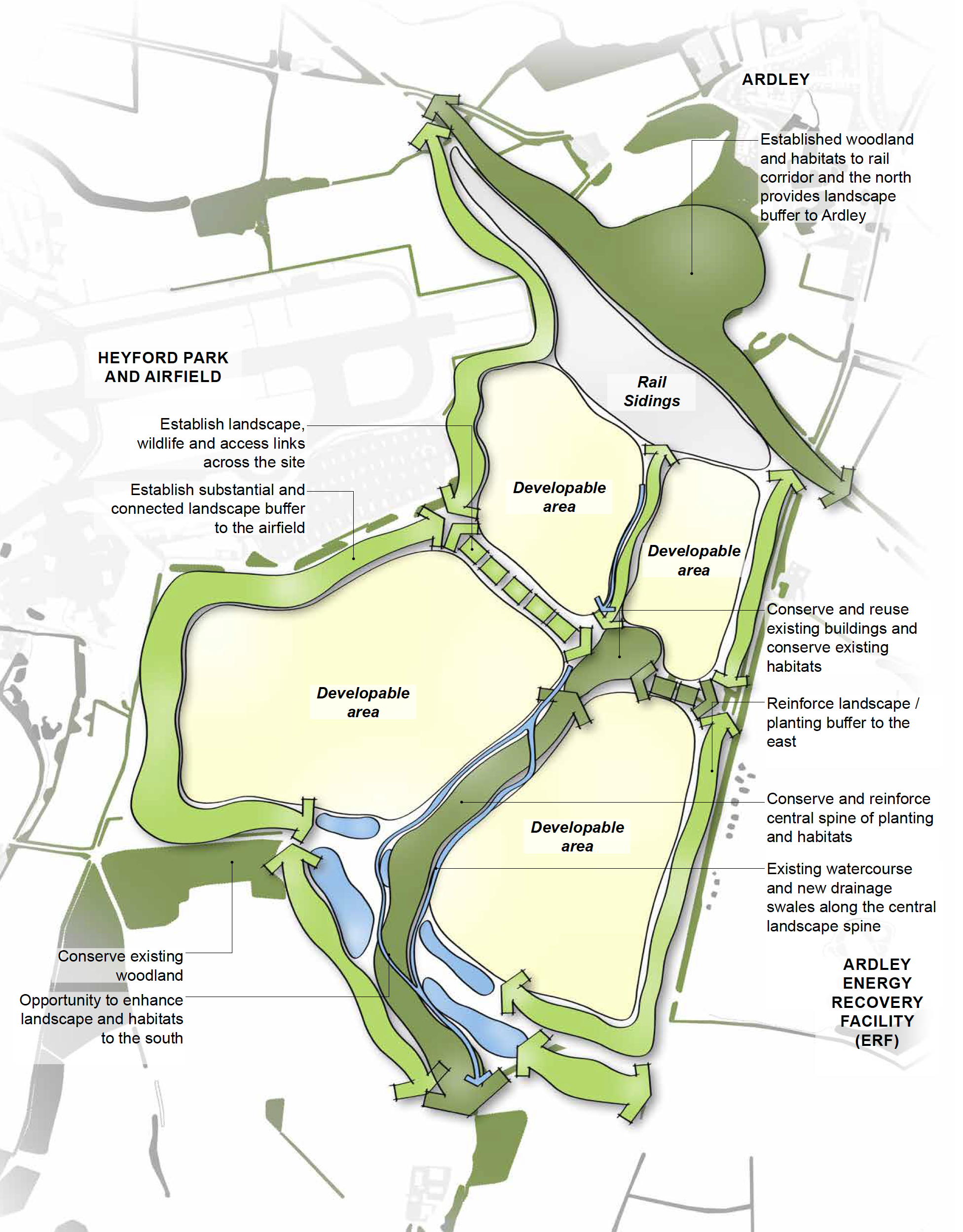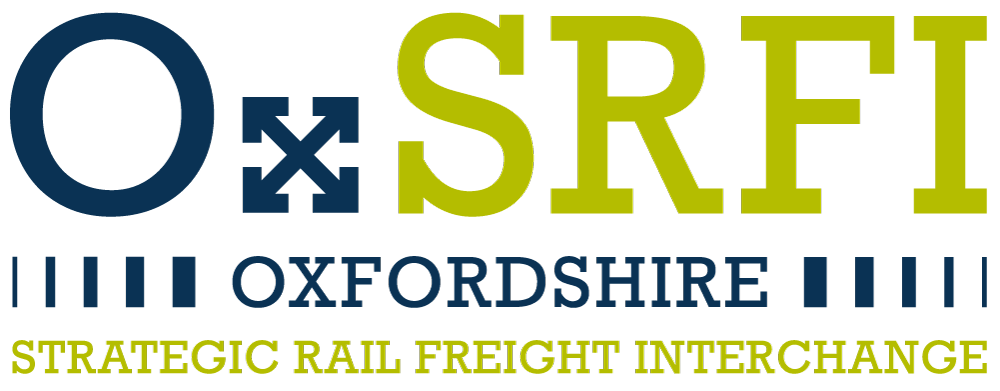The Proposal
Oxfordshire Railfreight Limited is proposing a Strategic Rail Freight Interchange (SRFI). A Strategic Rail Freight Interchange (SRFI) is a large multi-purpose freight interchange and distribution centre linked into both the rail and trunk road systems. It has rail-served warehousing and container handling facilities, and enables freight to be transferred between transport modes (i.e. from lorry to train, or vice versa). An SRFI allows rail to be used to best effect to undertake the long-haul primary trunk journey, with other modes (usually road) providing the secondary, and often final, delivery leg of the journey.
Government policy is to encourage ‘a network’ of SRFI’s across the UK to help meet economic and environmental opportunities and challenges.
This page of the website summarises the proposals and some of the key features and benefits. Also see the consultation exhibition boards which provide an overview and emerging details of the application.
ILLUSTRATIVE MASTERPLAN: WIDER CONTEXT (DRAFT)

The Importance of Rail Freight
Source : Network Rail – a generic video used by Network Rail which supports the concept of rail freight
Vision – Responsible Development is our Guiding Principle
Mountpark is committed to delivering a high-quality multi modal logistics campus. This means developing a campus which is highly efficient, creates an attractive working environment but has environmental responsibility as a guiding principle.
Some key components of the scheme are:
- around 45% of the Main Site will be landscaped green space
- the scheme will involve the planting of in excess of 100,000 new native trees and 12km of new hedgerow
- buildings and freight activity will be screened by substantial landscaped mounding
- the proposals will play a direct role in enabling the transition to a more sustainable economy with rail freight being around 73% more carbon efficient than road freight
- the scheme will deliver a significant net gain in biodiversity
- committing to achieve net-zero carbon in construction whilst also seeking to maximise capabilities for customers operationally
- the scheme will include sustainable energy consumption and production with a net zero carbon ambition
- the scheme will create a campus environment – prioritising employees health and wellbeing


In summary, the proposals would include the following elements:
- A new rail freight interchange;
- Approx. 6.5m sq. ft. of rail served warehousing;
- Substantial new landscaping and green infrastructure;
- Significant highways improvements including:
- Improvements to Junction 10 of the M40;
- An Ardley Bypass to the east of Ardley – the Bypass is proposed from the Ardley Roundabout on an alignment east of the B430, and would also serve as the Principal Access to the Main Site. The B430 would be stopped up through Ardley , removing all through-traffic;
- A Heyford Park Link Road from the B430 – a new single carriageway road which will provide a link from the B430 north of Middleton Stoney to Heyford Park, tied into Camp Road. The Main Site’s secondary access for buses, cyclists and pedestrians will be formed from this new link;
- A Middleton Stoney Relief Road – a new single carriageway road to the north-eastern side of Middleton Stoney which will provide a link from the B4030 to the B430 north of Middleton Stoney running to the north-east of the village;
- The principal access to the Main Site will be from the new Ardley bypass and from a new roundabout on the B430 – this primary access will serve all HGV traffic accessing the site.
The Documents page contains a range of draft application plans and other documents, but these two plans provide a useful summary of the proposals as a whole:
Access and Transport
The proposals include not only new rail infrastructure, but also new road infrastructure to ensure appropriate access to serve the new development – the key highways elements of the proposals are summarised above.
The Proposed Development is in a highly accessible location, adjacent to Junction 10 of the M40, and with good access to the A43 and A34 which provide connections to key distribution markets including London and Birmingham, but also to the south-coast ports.
Significant growth (housing and population) is planned locally at Bicester and Upper Heyford, and the site also has easy access to key urban centres including Oxford and Banbury. Once fully operational the proposed development is forecast to generate up to 1300 car trips and 300 HGV trips during the morning and evening peak hours. In order to accommodate the traffic associated with the scheme the proposals will deliver significant investment and physical improvement to the highway network.
The strategy is being informed by an ongoing process which is being steered by a Transport Working Group (TWG) including National Highways, Oxfordshire County Council, and the Applicant, which has been in place since 2020. The transport work will be informed by detailed modelling using an approved traffic model, and the results will be shared with, and scrutinised by, the TWG over the coming months. However, key benefits of the emerging strategy are considered to include:
- significantly reduced congestion at M40 Junction 10 and improved journey times.
- all through traffic removed from Ardley village.
- significant reductions in the level of traffic passing through the centre of Middleton Stoney.
In addition to new highways, the proposals include substantial new and retained rights of way and other walking and cycling infrastructure, both within the site, and connecting to existing routes and networks nearby.
The proposed approach is to provide a flexible Public Transport Strategy which will allow bus service frequency and hours of operation to respond to the end user requirements as the Proposed Development is built out. This will ensure that the bus services are suitable to serve the principal settlements from which the employees are sourced, maximise the attractiveness of a bus commute to and from the Main Site, and ensure the bus services are commercially sustainable in the long run.
However, in keeping with the position established for the adjacent Heyford Park development, the Public Transport Strategy for the Proposed Development will be focused on providing a frequent bus service between the Main Site and Bicester. The development would provide a new bespoke 15-minute frequency bus service during peak hours and shift change times direct to Bicester, which would loop through the Main Site and route along the Middleton Stoney Relief Road. The bus service would be in place from first occupation to make it an attractive and realistic alternative to the private car. The potential to provide a regular bus service to and from Banbury would also be explored.
Our proposed Strategic Rail Freight Interchange will deliver the following benefits:

Site will deliver low carbon development with renewable energy generation and buildings which meet at least BREEAM ‘Excellent’ standards.

Creation of around 9,500 jobs – plus even more in the supply chain

Delivering training
and apprenticeship
opportunities

Generating Business
Rates of around £20
million annually

£333.2 million Gross
Value Added
annually

Committed to delivery of 10% Biodiversity Net Gain

Rail freight produces 73% less CO2 emissions than HGVs/road freight

Connectivity to major deep sea ports (Felixstowe, London Gateway and Liverpool)

Each freight train can remove up to 76 HGVs from our roads, lowering carbon emissions and reducing congestion
Economic Benefits
Using standard employment densities, and experiences of similar schemes elsewhere, the site is expected to accommodate somewhere in the region of 9500 jobs once operational, This estimate of employment is generated using national standard job density data published by the Homes & Communities Agency (HCA) which suggests the site will deliver an average of one job per 77 sq.m. The Transport Assessment will assume a worst-case scenario in terms of potential traffic based around the highest
likely employment assumptions.
A range of new job types will be created, covering a wide range of skills and qualifications, and using experience and data from other similar sites it is possible to estimate an approximate mix of job types. Based on trends in the distribution sector, around a quarter of jobs will be defined as ‘highly skilled’, with a similar amount classed as ‘low skilled’, and the remainder (approximately half) ‘middle skilled’. The typical breakdown of jobs in this sector would generally include:
%
driving roles
%
in office based roles including Information Technology, customer service, sales, and engineering support
%
in managerial roles
%
other roles.
Typically around 80% of all jobs would be full-time, with the remaining 20% parttime, and there would be a mixture of shift based as well as standard hours jobs. The assessment of economic benefits is based on an area derived from Census data regarding travel to work patterns. The employment and economic impacts of the scheme are likely to be focused on Oxfordshire, particularly the area around Bicester.
Gross Value Added (GVA) as a measure of economic value from the proposals is estimated to be around £333 million per annum. That represents a significant investment in the local economy and is in addition to the capital costs of development which are likely to be well in excess of £500 million. The construction process would also generate a mixture of temporary and permanent employment, over the construction period.
Design Response to the Site and Context
The proposals respond to the local context through an emerging masterplan which seeks to maximise the benefits offered by the site’s specific characteristics and location.
Key potential constraints onsite include the presence of an existing water-course and existing woodland areas, a listed building within the site, as well as the potential for visual effects on the nearest communities. However, some of these features also present opportunities for the proposed development. Key examples include:
- retention of the listed building as part of a central ‘hub’ area which will provide amenities and facilities to support and enhance the experience of users of the site; and,
- retention of existing trees and woodland associated with the watercourse which are proposed as part of the extensive ‘green infrastructure’ and landscaping within the site.
Such features offer benefits in terms of retained and improved biodiversity as well as in terms of having established features within the site from the outset.
Further details are shown on the draft Illustrative Landscape Framework plan and the cross-sections included on the consultation exhibition Boards.
CONCEPT LANDSCAPE FRAMEWORK


APPROX 45% of the Main Site area is proposed as Green Infrastructure and Landscaping
